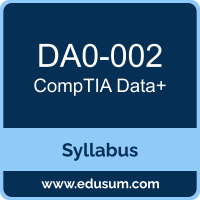 Use this quick start guide to collect all the information about CompTIA Data+ (DA0-002) Certification exam. This study guide provides a list of objectives and resources that will help you prepare for items on the DA0-002 CompTIA Data+ exam. The Sample Questions will help you identify the type and difficulty level of the questions and the Practice Exams will make you familiar with the format and environment of an exam. You should refer this guide carefully before attempting your actual CompTIA Data Plus certification exam.
Use this quick start guide to collect all the information about CompTIA Data+ (DA0-002) Certification exam. This study guide provides a list of objectives and resources that will help you prepare for items on the DA0-002 CompTIA Data+ exam. The Sample Questions will help you identify the type and difficulty level of the questions and the Practice Exams will make you familiar with the format and environment of an exam. You should refer this guide carefully before attempting your actual CompTIA Data Plus certification exam.
The CompTIA Data+ certification is mainly targeted to those candidates who want to build their career in Data domain. The CompTIA Data+ exam verifies that the candidate possesses the fundamental knowledge and proven skills in the area of CompTIA Data Plus.
CompTIA Data+ Exam Summary:
| Exam Name | CompTIA Data+ |
| Exam Code | DA0-002 |
| Exam Price | $255 (USD) |
| Duration | 90 mins |
| Number of Questions | 90 |
| Passing Score | 720 (on a scale of 100–900) |
| Books / Training | CompTIA CertMaster Learn |
| Schedule Exam | Pearson VUE |
| Sample Questions | CompTIA Data+ Sample Questions |
| Practice Exam | CompTIA DA0-002 Certification Practice Exam |
CompTIA DA0-002 Exam Syllabus Topics:
| Topic | Details |
|---|---|
Data Concepts and Environments - 20% |
|
| Explain data concepts. |
- Database types
- File extensions
- Data structures
- Data types
|
| Identify types of data sources. |
- Databases
- Application programming interfaces (APIs)
- Website data
- Files
- Logs
- Data repositories
|
| Identify infrastructure concepts. |
- Cloud providers
- Cloud and on-premises infrastructure
- Storage types
- Containerization
|
| Identify common data analysis tools. |
- Coding environments
- Business intelligence software
- Packages/libraries
- Programming languages
- Database management system (DBMS)
|
| Identify artificial intelligence (AI) concepts. |
- Generative AI
- Foundational models
- Deep learning - Natural language processing (NLP) - Robotic process automation (RPA)
|
Data Acquisition and Preparation - 22% |
|
| Given a scenario, use data acquisition methods. |
- Data integration
- Querying
- Basic query optimization
- Extract, transform, load (ETL)/extract, load, transform (ELT)
- Data collection
|
|
Given a scenario, perform data exploration to identify possible inconsistencies with a data set.
|
- Missing values
- Duplication - Redundancy - Outliers - Completeness - Validation |
| Given a scenario, perform appropriate data transformation and cleansing techniques. |
- String manipulation
- Conversion
- Clustering
- Augmentation
- Exploding - Scaling - Standardization - Imputation - Parsing - Merging - Appending - Derived variables
- Deletion
|
Data Analysis - 24% |
|
|
Given a set of requirements, determine the appropriate communication approach for data analysis.
|
- Mock-up
- Accessibility
- Technical vs. nontechnical audience
- Level of detail - Internal vs. external - User persona type
- Sensitive vs. non-sensitive
- Key performance indicators (KPIs) |
| Given a scenario, select the appropriate statistical method or function. |
- Basic statistical methods
- Functions and measures
|
| Given a scenario, troubleshoot basic issues using the appropriate tool or method. |
- Issues
- Tools and methods
|
Visualization and Reporting - 20% |
|
| Given a scenario, use the appropriate visual elements. |
- Types
- Design elements
|
| Given a scenario, use the appropriate delivery or consumption method. |
- Executive summary
- Self-service portal - Dashboards
- Data versioning techniques
|
| Given a scenario, troubleshoot issues using report validation techniques. |
- Issues
- Techniques
|
Data Governance - 14% |
|
| Explain data management concepts. |
- Integration
- Documentation
- Source of truth
- Data versioning
- Metadata
|
| Summarize concepts related to data compliance. |
- Retention
- General Data Protection Regulation (GDPR) - Jurisdictional requirements - Replication - Storage - Data ethics - Payment Card Industry Data Security Standard (PCI DSS) - Audit - Classification - Incident reporting
|
| Compare and contrast data privacy and protection practices. |
- Role-based access control
- Encryption
- Data usage
- Data sharing - National Institute Standards and Technology (NIST) - Personal identifiable information (PII) - Personal health information (PHI) - Anonymization - Masking |
| Compare and contrast data quality assurance practices. |
- Requirement testing
- Stress test - User acceptance test (UAT) - Source control - Unit test - Data health check
- Automated data quality monitoring
- Data profiling
- International Organization for Standardization (ISO)
|
To ensure success in CompTIA Data Plus certification exam, we recommend authorized training course, practice test and hands-on experience to prepare for CompTIA Data+ (DA0-002) exam.
